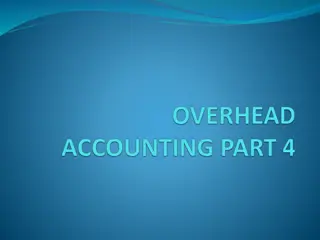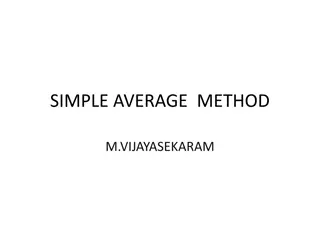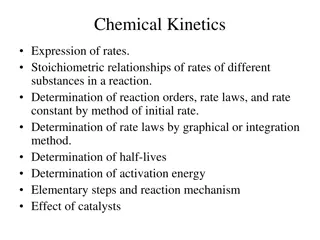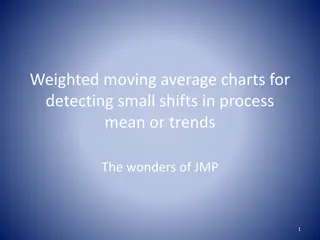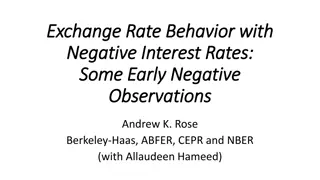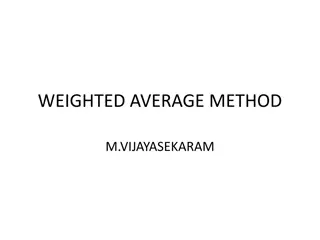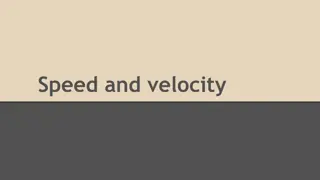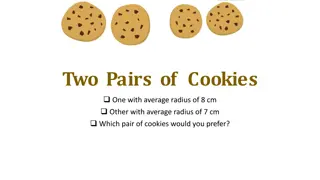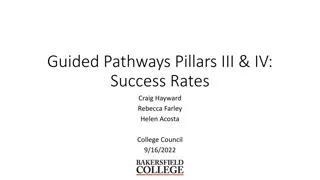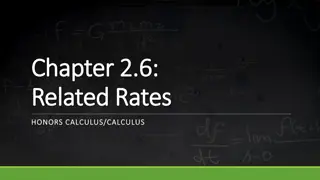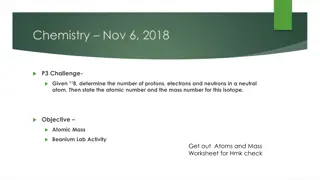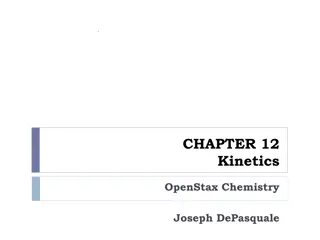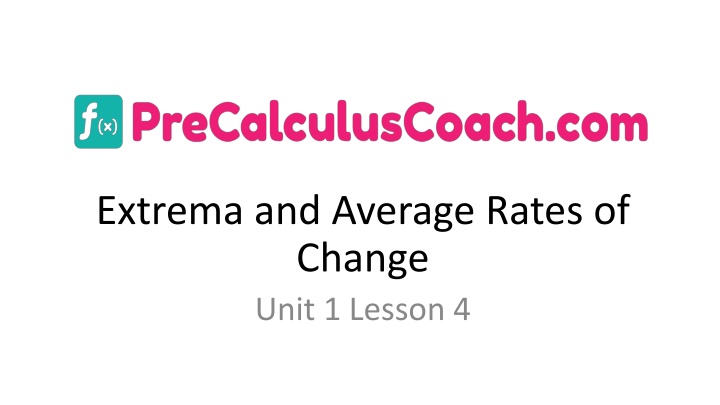
Extrema and Average Rates of Change in Functions
Discover how to interpret key features of graphs and tables, calculate average rates of change, and identify critical points in functions to understand extrema and average rates of change. Dive into the increasing and decreasing behaviors of functions and tackle sample problems.
Download Presentation

Please find below an Image/Link to download the presentation.
The content on the website is provided AS IS for your information and personal use only. It may not be sold, licensed, or shared on other websites without obtaining consent from the author. If you encounter any issues during the download, it is possible that the publisher has removed the file from their server.
You are allowed to download the files provided on this website for personal or commercial use, subject to the condition that they are used lawfully. All files are the property of their respective owners.
The content on the website is provided AS IS for your information and personal use only. It may not be sold, licensed, or shared on other websites without obtaining consent from the author.
E N D
Presentation Transcript
Extrema and Average Rates of Change Unit 1 Lesson 4
Extrema and Average Rates of Change Students will be able to: Interpret key features of graphs and tables in terms of the quantities, and sketch graphs showing key features given a verbal description of the relationship. Key features include: intervals where the function is increasing, decreasing, positive, or negative; relative maximums and minimums. Calculate and interpret the average rate of change of a function (presented symbolically or as a table) over a specified interval. Estimate the rate of change from a graph.
Extrema and Average Rates of Change Key Vocabulary: Critical points, Absolute maximum and minimum, Relative maximum and minimum, A point of inflection, Average rates of change.
Extrema and Average Rates of Change Increasing and Decreasing Behavior A function ? is increasing on an interval ? if and only if for every ? and ? contained in ?, ? < ? ? , whenever ? < ?. A function ? is decreasing on an interval ? if and only if for every ? and ? contained in ?, ? ? > ? ? whenever ? < ?. A function ? remains constant on an interval ? if and only if for every ? and ? contained in ?, ? ? = ? ? whenever ? < ?.
Extrema and Average Rates of Change Points in the domain of a function where the function changes from increasing to decreasing or from decreasing to increasing are called critical points. At these points, a line drawn tangent to the curve is horizontal or vertical.
Extrema and Average Rates of Change Sample Problem 1: Use the graph of each function to estimate intervals on which the function is increasing, decreasing, or constant. Support the answer numerically. a. ? ? = ??+ ?? + ? 7 y 6 5 4 3 2 1 x -7 -6 -5 -4 -3 -2 -1 1 2 3 4 5 6 7 -1 -2 -3 -4 -5 -6
Extrema and Average Rates of Change Sample Problem 1: Use the graph of each function to estimate intervals on which the function is increasing, decreasing, or constant. Support the answer numerically. a. ? ? = ??+ ?? + ? 7 y From the graph, it appears that: A function ??+ ?? + ? is 6 5 4 decreasing for ? < ?. A function ??+ ?? + ? is increasing for ? > ?. The critical point is ( ?,?). 3 2 1 x -7 -6 -5 -4 -3 -2 -1 1 2 3 4 5 6 7 -1 -2 -3 -4 -5 -6
Extrema and Average Rates of Change Sample Problem 1: Use the graph of each function to estimate intervals on which the function is increasing, decreasing, or constant. Support the answer numerically. a. ? ? = ??+ ?? + ? 7 y ? ? ? ? ? ? ? 6 5 4 3 ? ?? ? ? ? ? ?? 2 1 x -7 -6 -5 -4 -3 -2 -1 1 2 3 4 5 6 7 -1 -2 The table supports this conjecture. -3 -4 -5 -6
Extrema and Average Rates of Change Sample Problem 1: Use the graph of each function to estimate intervals on which the function is increasing, decreasing, or constant. Support the answer numerically. b. ? ? = ?? ?? ? y 5 4 3 2 1 x -5 -4 -3 -2 -1 1 2 3 4 5 -1 -2 -3 -4 -5
Extrema and Average Rates of Change Sample Problem 1: Use the graph of each function to estimate intervals on which the function is increasing, decreasing, or constant. Support the answer numerically. b. ? ? = ?? ?? ? From the graph, it appears that: A function ?? ?? ? is increasing for ? < ? ??? ? > ?. A function ?? ?? ? is decreasing for ? < ? < ?. The critical points are: ?,? ??? ?,? -4 y 5 4 3 2 1 x -5 -4 -3 -2 -1 1 2 3 4 5 -1 -2 -3 -5
Extrema and Average Rates of Change Sample Problem 1: Use the graph of each function to estimate intervals on which the function is increasing, decreasing, or constant. Support the answer numerically. b. ? ? = ?? ?? ? ? < ? y 5 4 ? ? ? ? ? ?.? 3 2 1 ? ??? ?? ?? ? ?.??? x -5 -4 -3 -2 -1 1 2 3 4 5 -1 -2 -3 -4 -5
Extrema and Average Rates of Change Sample Problem 1: Use the graph of each function to estimate intervals on which the function is increasing, decreasing, or constant. Support the answer numerically. b. ? ? = ?? ?? ? ? < ? < ? y 5 4 ? ?.? ?.? ? ?.? ?.? 3 2 1 ? ?.??? ?.??? ? ?.??? ?.??? x -5 -4 -3 -2 -1 1 2 3 4 5 -1 -2 -3 -4 -5
Extrema and Average Rates of Change Sample Problem 1: Use the graph of each function to estimate intervals on which the function is increasing, decreasing, or constant. Support the answer numerically. b. ? ? = ?? ?? ? ? > ? y 5 4 ? ?.? ?.? ? ? ? 3 2 1 ? ?.??? ?.??? ? ?? ?? x -5 -4 -3 -2 -1 1 2 3 4 5 -1 -2 The tables support this conjecture. -3 -4 -5
Extrema and Average Rates of Change Extrema are critical points at which a function changes its increasing or decreasing behavior. At these points, the function has a maximum or a minimum value, either relative or absolute. The greatest value that a function assumes over its domain is called the absolute maximum. The least value that a function assumes over its domain is called the absolute minimum.
Extrema and Average Rates of Change A relative maximum value of a function may not be the greatest value of ? on the domain, but it is the greatest value on some interval of the domain. A relative minimumvalue of a function is the least value on some interval of the domain.
Extrema and Average Rates of Change A point of inflection can also be a critical point. At these points, the graph changes its shape, but not it s increasing or decreasing behavior. Instead, the curve changes from being bent upward to being bent downward, or vice versa.
Extrema and Average Rates of Change Sample Problem 2: Estimate and classify the extrema for the graph of each function. Support the answers numerically. ? ? = ??+ ???+ ? ? a. y 5 4 3 2 1 x -5 -4 -3 -2 -1 1 2 3 4 5 -1 -2 -3 -4 -5
Extrema and Average Rates of Change Sample Problem 2: Estimate and classify the extrema for the graph of each function. Support the answers numerically. ? ? = ??+ ???+ ? ? a. From the graph, it appears that: ? ? has relative minimum in ? = ?.?? ? ? has relative maximum in ? = ?.?? ??? ? ? ? = and ??? ? ? has no absolute maxima and absolute minima. y 5 4 3 2 1 x -5 -4 -3 -2 -1 1 2 3 4 5 -1 ? ? ? = -2 -3 -4 -5
Extrema and Average Rates of Change Sample Problem 2: Estimate and classify the extrema for the graph of each function. Support the answers numerically. ? ? = ??+ ???+ ? ? a. y ? < ?.?? ?? , ?.?? 5 4 ? ? ?.?? ? ?.? ?.?? 3 2 1 x ? ?? ?.??? ?.? ?.??? ?.? -5 -4 -3 -2 -1 1 2 3 4 5 -1 -2 -3 -4 -5
Extrema and Average Rates of Change Sample Problem 2: Estimate and classify the extrema for the graph of each function. Support the answers numerically. ? ? = ??+ ???+ ? ? a. y 5 ?.?? < ? < ?.?? ?? ?.??;?.?? 4 3 2 ? ?.? ? ?.? ?.?? ?.?? 1 x -5 -4 -3 -2 -1 1 2 3 4 5 ? ?.??? ? ?.?? ?.??? ?.? -1 -2 -3 -4 -5
Extrema and Average Rates of Change Sample Problem 2: Estimate and classify the extrema for the graph of each function. Support the answers numerically. ? ? = ??+ ???+ ? ? a. y ? > ?.?? ?? ?.??; 5 4 3 ? ?.? ? ?.? ? ?.? 2 1 x ? ?.??? ? ?.??? ?? ??.?? -5 -4 -3 -2 -1 1 2 3 4 5 -1 -2 -3 The tables support this conjecture. -4 -5
Extrema and Average Rates of Change Sample Problem 2: Estimate and classify the extrema for the graph of each function. Support the answers numerically. ? ? = ??+ ???+ ? ? a. For interval ,?.?? the function is decreasing. In ? = ?.??, ? ? has relative minimum. For interval ?.??;?.?? the function is increasing. In ? = ?.??, ? ? has relative maximum. For interval ?.??; the function is decreasing. y 5 4 3 2 1 x -5 -4 -3 -2 -1 1 2 3 4 5 -1 -2 -3 -4 -5
Extrema and Average Rates of Change Sample Problem 2: Estimate and classify the extrema for the graph of each function. Support the answers numerically. ? ? = ??+ ??? b. y 5 4 3 2 1 x -5 -4 -3 -2 -1 1 2 3 4 5 -1 -2 -3 -4 -5
Extrema and Average Rates of Change Sample Problem 2: Estimate and classify the extrema for the graph of each function. Support the answers numerically. ? ? = ??+ ??? b. From the graph, it appears that: ? ? has relative minimum in ? = ? ? ? has absolute maximum in ? = ?.?? and ? = ?.?? ??? ? ? ? = and ??? ? ? has no absolute minima. y 5 4 3 2 1 x ? ? ? = -5 -4 -3 -2 -1 1 2 3 4 5 -1 -2 -3 -4 -5
Extrema and Average Rates of Change Sample Problem 2: Estimate and classify the extrema for the graph of each function. Support the answers numerically. ? ? = ??+ ??? b. y 5 ? < ?.?? ?? ; ?.?? 4 3 ? ? ?.? ? ?.? 2 1 x ? ?? ??.?? ? ?.?? -5 -4 -3 -2 -1 1 2 3 4 5 -1 -2 -3 -4 -5
Extrema and Average Rates of Change Sample Problem 2: Estimate and classify the extrema for the graph of each function. Support the answers numerically. ? ? = ??+ ??? b. y ?.?? < ? < ? ?? ?.??;? 5 4 3 ? ?.?? ?.?? ?.?? ? 2 1 x ? ?.?? ?.?? ?.?? ? -5 -4 -3 -2 -1 1 2 3 4 5 -1 -2 -3 -4 -5
Extrema and Average Rates of Change Sample Problem 2: Estimate and classify the extrema for the graph of each function. Support the answers numerically. ? ? = ??+ ??? b. y ? < ? < ?.?? ?? ?;?.?? 5 4 3 ? ?.?? ?.?? ?.? ?.?? 2 1 x ? ?.?? ?.?? ? ?.?? -5 -4 -3 -2 -1 1 2 3 4 5 -1 -2 -3 -4 -5
Extrema and Average Rates of Change Sample Problem 2: Estimate and classify the extrema for the graph of each function. Support the answers numerically. ? ? = ??+ ??? b. y 5 ? > ?.?? ?? ?.??; 4 3 ? ?.? ?.? ?.? ?.? 2 1 x ? ?.?? ? ??.?? ?? -5 -4 -3 -2 -1 1 2 3 4 5 -1 -2 -3 The tables support this conjecture. -4 -5
Extrema and Average Rates of Change Sample Problem 2: Estimate and classify the extrema for the graph of each function. Support the answers numerically. ? ? = ??+ ??? b. For interval ; ?.?? the function is increasing. In ? = ?.??, ? ? has absolute maximum. For interval ?.??;? the function is decreasing. In ? = ?, ? ? has relative minimum. For interval ?;?.?? the function is increasing. In ? = ?.??, ? ? has absolute maximum. For interval ?.??; the function is decreasing. y 5 4 3 2 1 x -5 -4 -3 -2 -1 1 2 3 4 5 -1 -2 -3 -4 -5
Extrema and Average Rates of Change Average Rate of Change The average rate of change between any two points on the graph of ? is the slope of the line through those points. The line through two points on a curve is called a secant line. The slope of the secant line is denoted ????.
Extrema and Average Rates of Change The average rate of change on the interval [??;??]is: ????=? ?? ? ?? ?? ?? When the average rate of change over an interval is positive, the function increases on average over that interval. When the average rate of change is negative, the function decreases on average over that interval.
Extrema and Average Rates of Change Sample Problem 3: Find the average rate of change of each function on the given interval. ? ? = ???+ ?? ? ?;? a.
Extrema and Average Rates of Change Sample Problem 3: Find the average rate of change of each function on the given interval. ? ? = ???+ ?? ? ?;? ? ?? ? ?? ?? ?? ? ? =? ??+ ? ? ? (? ??+ ? ? ?) ? =?? + ? ? (? + ? ?) ? =?? ? ? a. =? ? ? ? = = = The average rate of change on the interval ?;? is ??. . =?? ?= ??
Extrema and Average Rates of Change Sample Problem 3: Find the average rate of change of each function on the given interval. b. ? ? =? ? ? ? ? ?? ? ?? ?? ?? ? ? ? ? ? ? ? ? ? ? ? The average rate of change on the interval ?; ?is ? ? ?; ? =? ? ? ? = = = =? ? ? ?. = ? ?
Extrema and Average Rates of Change Computing Average Rate of Change from a Graph Sample Problem 4: Find the average rate of change of a function on the given interval. a. ? ? = ??+ ?? ? ?;? y 6 5 4 3 2 1 x -5 -4 -3 -2 -1 1 2 3 4 5 -1 -2 -3 -4 -5 -6
Extrema and Average Rates of Change Computing Average Rate of Change from a Graph Sample Problem 4: Find the average rate of change of a function on the given interval. a. ? ? = ??+ ?? ? ?;? ? ?? ? ?? y =? ? ? ? ? ( ?) 6 = 5 ?? ?? ? ? ? ( ?)= ? 4 3 2 = = ? 1 ? x -5 -4 -3 -2 -1 1 2 3 4 5 -1 -2 -3 -4 -5 -6

